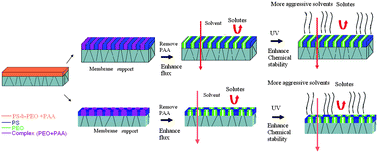Ordered nanoporous membranes based on diblock copolymers with high chemical stability and tunable separation properties†
Abstract

* Corresponding authors
a
Centre for Surface Chemistry and Catalysis, Faculty of Bioscience Engineering, Katholieke Universiteit Leuven (K.U.Leuven), Kasteelpark Arenberg 23—Box 2461, Leuven, Belgium
E-mail:
ivo.vankelecom@biw.kuleuven.be
b
Institute of Condensed Matter and Nanosciences (IMCN), Université catholique de Louvain, Place L. Pasteur 1, Louvain-la-Neuve, Belgium
E-mail:
charles-andre.fustin@uclouvain.be
c Laboratory of Photochemistry and Spectroscopy, Division of Molecular and Nanomaterials, and INPAC—Institute for Nanoscale Physics and Chemistry, Katholieke Universiteit Leuven (K.U.Leuven), Celestijnenlaan 200 F, Leuven, Belgium
d Nuclear Methods in Materials Science, Department of Subatomic and Radiation Physics, Ghent University, Gent, Belgium
e LRT2, Universität der Bundeswehr München, Werner-Heisenberg-Weg39, Neubiberg, Germany

 Please wait while we load your content...
Something went wrong. Try again?
Please wait while we load your content...
Something went wrong. Try again?
X. Li, C. Fustin, N. Lefèvre, J. Gohy, S. D. Feyter, J. D. Baerdemaeker, W. Egger and I. F. J. Vankelecom, J. Mater. Chem., 2010, 20, 4333 DOI: 10.1039/B926774C
To request permission to reproduce material from this article, please go to the Copyright Clearance Center request page.
If you are an author contributing to an RSC publication, you do not need to request permission provided correct acknowledgement is given.
If you are the author of this article, you do not need to request permission to reproduce figures and diagrams provided correct acknowledgement is given. If you want to reproduce the whole article in a third-party publication (excluding your thesis/dissertation for which permission is not required) please go to the Copyright Clearance Center request page.
Read more about how to correctly acknowledge RSC content.
 Fetching data from CrossRef.
Fetching data from CrossRef.
This may take some time to load.
Loading related content
